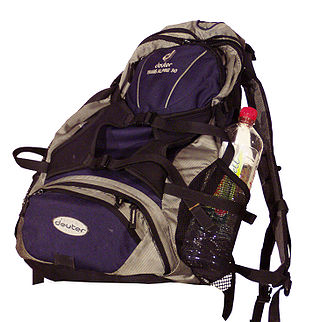
A backpack—also called knapsack, rucksack, pack, booksack, bookbag, haversack or backsack—is, in its simplest frameless form, a fabric sack carried on one's back and secured with two straps that go over the shoulders, but it can have an external frame, internal frame, and there are bodypacks.
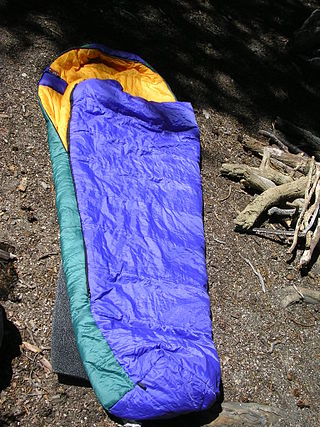
A sleeping bag is an insulated covering for a person, essentially a lightweight quilt that can be closed with a zipper or similar means to form a tube, which functions as lightweight, portable bedding in situations where a person is sleeping outdoors. It is also commonly used indoors for people who do not have beds or at sleepovers. Its primary purpose is to provide warmth and thermal insulation through its synthetic or down insulation. It also typically has a water-resistant or water-repellent cover that protects, to some extent, against wind chill and light precipitation, but a tent is usually used in addition to a sleeping bag, as it performs those functions better. The bottom surface also provides some cushioning, but a sleeping pad or camp cot is usually used in addition to that purpose. The bottom surface of a sleeping bag may be moderately water repellent, but a plastic tarp or groundsheet is often used to protect against moist ground.
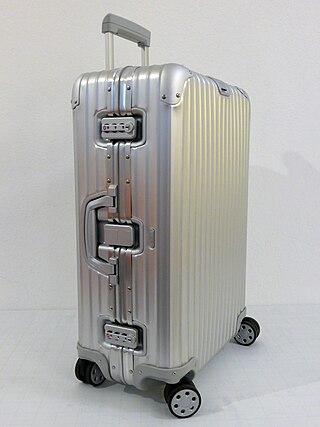
Baggage or luggage consists of bags, cases, and containers which hold a traveler's personal articles while the traveler is in transit. A modern traveler can be expected to have packages containing clothing, toiletries, small possessions, trip necessities. On the return trip, travelers may have souvenirs and gifts. For some people, luggage and the style thereof is representative of the owner's wealth and status. Luggage is constructed to protect the items during travel either with a hard shell or a durable soft material. Luggage often has internal subdivisions or sections to aid in securing items. Handles are typically provided to facilitate carrying, and some luggage may have wheels and/or telescoping handles or leashes to make moving them easier.

A handbag, commonly known as a purse in North American English, is a handled medium-to-large bag used to carry personal items. It has also been called a pocketbook in parts of the U.S.

A paper bag is a bag made of paper, usually kraft paper. Paper bags can be made either with virgin or recycled fibres to meet customers' demands. Paper bags are commonly used as shopping carrier bags and for packaging of some consumer goods. They carry a wide range of products from groceries, glass bottles, clothing, books, toiletries, electronics and various other goods and can also function as means of transport in day-to-day activities.

A toolbox is a box to organize, carry, and protect the owner's tools. They could be used for trade, a hobby or DIY, and their contents vary with the craft.
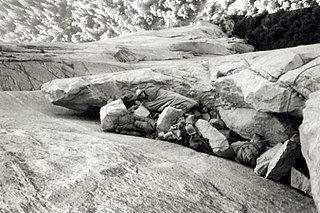
A bivouac shelter or bivvy is any of a variety of improvised camp site or shelter that is usually of a temporary nature, used especially by soldiers or people engaged in backpacking, bikepacking, scouting or mountain climbing. It may often refer to sleeping in the open with a bivouac sack, but it may also refer to a shelter constructed of natural materials like a structure of branches to form a frame, which is then covered with leaves, ferns and similar material for waterproofing and duff for insulation. Modern bivouacs often involve the use of one- or two-person tents but may also be without tents or full cover. In modern mountaineering the nature of the bivouac shelter will depend on the level of preparedness, in particular whether existing camping and outdoor gear may be incorporated into the shelter.

A messenger bag is a type of sack, usually made of cloth. It is worn over one shoulder with a strap that goes across the chest resting the bag on the lower back. While messenger bags are sometimes used by couriers, they are now also an urban fashion icon. Some types of messenger bags are called carryalls. A smaller version is often called a sling bag.
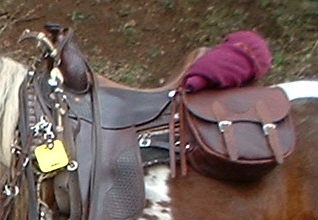
Saddlebags are bags that are attached to saddles.
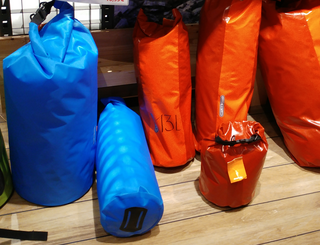
A dry bag is a type of flexible container which seals in a watertight manner. Dry bags are often used in kayaking, canoeing, rafting, canyoning, and other outdoor activities in which sensitive items would otherwise get wet, as well as extreme sports such as skiing and snowboarding. Dry bags are used to protect electronics from water. They are also used to prevent sleeping bags and spare clothing from getting wet, as in a camping context.

Ultralight backpacking is a style of lightweight backpacking that emphasizes carrying the lightest and least amount of gear. While no technical standards exist, some hikers consider "ultralight" to mean an initial base weight of less than 4.5 kg (9.9 lb). Base weight is the weight of a fully loaded backpack at the start of a trip, excluding worn weight and consumables such as food, water, and fuel. Base weight can be lowered by reducing the weight of individual items of gear, or by choosing not to carry that gear. Ultralight backpacking is most popular among thru-hikers.
A gig bag is a padded, soft-sided bag used for the storage and transport of musical instruments, most commonly a guitar or bass guitar. A popular alternative to the usually heavier, more cumbersome hard shell cases, most gig bags include pockets for storage of sheet music, instrument cables, picks, straps, and other accessories, along with shoulder straps and grab handles for added comfort, portability, and ease of use.

A zipper storage bag,slider storage bag,zipper bag,zip lock bag, or zippie is an inexpensive flexible rectangular storage bag, usually transparent, made of polyethylene or similar plastic, that can be sealed and opened many times, either by a slider, which works in a similar way to a zip fastener, or by pinching together the two sides of a mechanical sealing mechanism with one's fingers. The bags are made in many sizes; a typical small size is 1.5 by 2.5 inches, and a typical large size is 9 by 12 inches. Material thickness (gauge) varies; smaller bags are typically 40 to 45 µm.
Hiking equipment is the equipment taken on outdoor walking trips. Hiking is usually divided into day-hikes and multiple-day hikes, called backpacking, trekking, and walking tours.

In American English, a gym bag or carryall is a large bag made of cloth or leather typically with a rectangular base and a zippered opening at the top. Two handles enable the bag to be carried, and a strap lets the user support the bag on the shoulders.
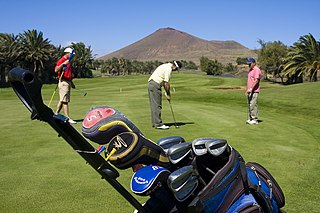
Golf equipment encompasses the various items that are used to play the sport of golf. Types of equipment include the golf ball, golf clubs, and devices that aid in the sport.

A bag is a common tool in the form of a non-rigid container, typically made of cloth, leather, paper or plastic. The use of bags predates recorded history, with the earliest bags being lengths of animal skin, cotton, or woven plant fibers, folded up at the edges and secured in that shape with strings of the same material. Bags can be used to carry items such as personal belongings, groceries, and other objects. They comes in various shapes and sizes, often equipped with handles or straps for easier carrying.
A garment bag or suit bag is a container of flexible material, usually used to ease transporting suits, jackets or clothing in general, and also to protect clothes from dust by hanging them inside with their hangers and then in the closet bar. The simplest models usually have a zipper that opens from top to bottom, in the middle of one side. They can be manufactured with different materials: fabric, leather, plastic, etc...
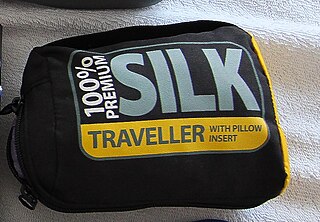
Sleeping bag liners are lightweight cloth sacks usually fitted inside sleeping bags to provide extra comfort, insulation, and help keep the sleeping bag clean.
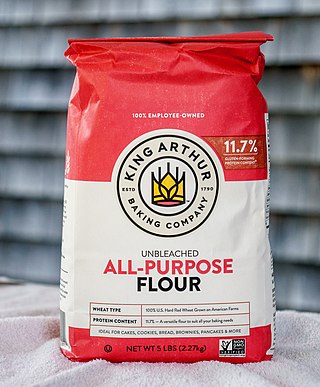
A flour sack or flour bag is a bag or sack for flour. Large bulk bags as well as smaller consumer sizes are available.

















